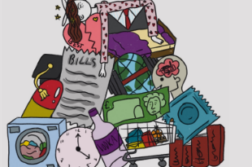For myself and many others, the turn of the decade has motivated a desire to try and have a more sustainable lifestyle, and one of the easiest ways to do that – if you aren’t compelled to adopt a plant-based diet – is to buy less clothing. The fashion industry alone is responsible for about 8% of global greenhouse emissions, outweighing the carbon footprint of international flights and shipping combined. For some, cutting down on shopping habits and sourcing your latest garms from a sustainable brand can be a tricky task, but sustainable shopping doesn’t have to be an arduous process.
Sustainable fashion brands are undeniably more expensive than their less environmentally friendly counterparts, but contrary to popular belief, a sustainable wardrobe refresh doesn’t have to break the bank. The shopping app Depop has become increasingly popular over the last few years, and is an easy alternative to online or high-street retailers, allowing users to buy clothing and other items second-hand. However, app users should be wary when browsing shops on Depop, as there are many sellers who bulk buy cheap clothes and sell them at an inflated price. When using apps such as Depop in an effort to be more sustainable, it’s important to just remember to check the seller’s account information and the products they’re selling. If they’ve got 20 identical t-shirts to sell, they’re most likely bulk-buying them from unsustainable sources.
Another argument many people present when justifying their love for fast fashion and reluctance to buy from sustainable brands is that clothing from sustainable fashion brands is simply too expensive. These people often like to buy the impressively cheap items you can find on sites like boohoo, SheIn, or PrettyLittleThing. Cashing out a little bit of money every week or so for some new clothes becomes a habit for a lot of people and, understandably, habits are hard to break.
Many buyers of fast fashion will end up spending a lot of money over an extended period of time on clothes that are poorly made, break easily and are subsequently replaced with the same cheap alternatives. Shoppers stuck in this cycle could easily afford a good quality, durable and sustainable item of clothing, if they just broke their habit and saved up for a little while.
What’s more, when you spend a reasonable amount of money on something, naturally, you care about it more, and will likely wear it more often than a cheaper alternative. Even if people don’t choose to save their money for a more sustainable choice, another easy way to reduce your carbon footprint is to simply buy less. Consumer culture and the widely-felt need to conform to the latest trends makes people feel like they need to buy items they don’t really love, and wouldn’t wear more than a couple of times.
My personal clothes shopping habits aren’t overly extensive. I’m generally not bothered by the need to dress to the latest trends, and will happily wear my clothes until they’re basically falling apart. My sister, on the other hand, will buy new clothes every week, more than once if she can – sometimes just to try the clothes on, take some pictures and return them the following day. So, maybe my desire to shop more sustainably is partly a response to that, and the need to try and counteract her harmful habits.
If you want to try and combat the fast fashion industry like me, maybe have a look at these shops next time you want to make an addition to your wardrobe:
Along with these shops, don’t forget to check out your local charity shops, Facebook Marketplace, and keep an eye out for Kilo Sales/Weigh’n’Pay events.



